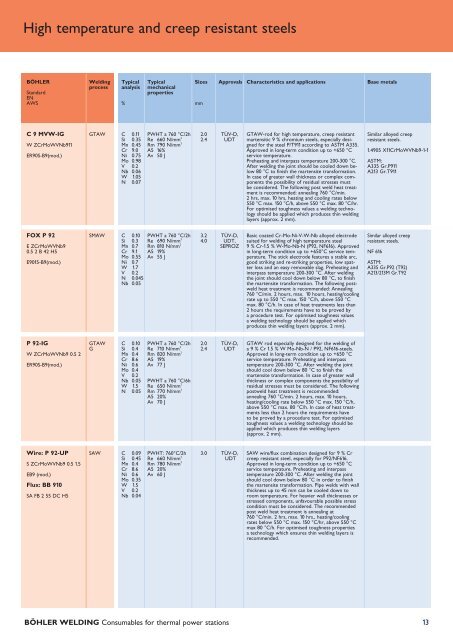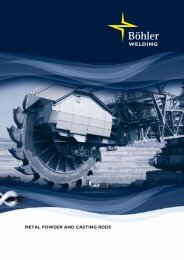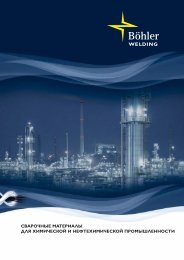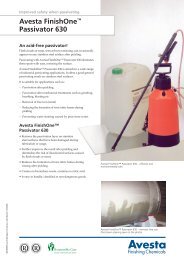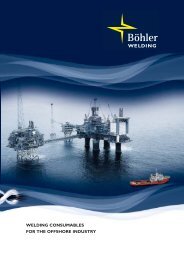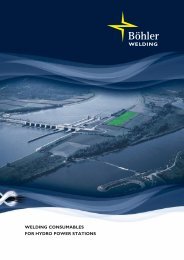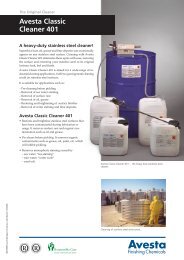WELDING Consumables for thermal power stations
WELDING Consumables for thermal power stations
WELDING Consumables for thermal power stations
You also want an ePaper? Increase the reach of your titles
YUMPU automatically turns print PDFs into web optimized ePapers that Google loves.
High temperature and creep resistant steels<br />
BÖHLER<br />
Standard<br />
EN<br />
AWS<br />
Welding<br />
process<br />
Typical<br />
analysis<br />
%<br />
Typical<br />
mechanical<br />
properties<br />
Sizes<br />
mm<br />
Approvals<br />
Characteristics and applications<br />
Base metals<br />
C 9 MVW-IG<br />
W ZCrMoWVNb911<br />
ER90S-B9(mod.)<br />
GTAW C 0.11<br />
Si 0.35<br />
Mn 0.45<br />
Cr 9.0<br />
Ni 0.75<br />
Mo 0.98<br />
V 0.2<br />
Nb 0.06<br />
W 1.05<br />
N 0.07<br />
PWHT a 760 °C/2h<br />
Re 660 N/mm 2<br />
Rm 790 N/mm 2<br />
A5 16%<br />
Av 50 J<br />
2.0<br />
2.4<br />
TÜV-D,<br />
UDT<br />
GTAW-rod <strong>for</strong> high temperature, creep resistant<br />
martensitic 9 % chromium steels, especially designed<br />
<strong>for</strong> the steel P/T911 according to ASTM A335.<br />
Approved in long-term condition up to +650 °C<br />
service temperature.<br />
Preheating and interpass temperature 200-300 °C.<br />
After welding the joint should be cooled down below<br />
80 °C to finish the martensite trans<strong>for</strong>mation.<br />
In case of greater wall thickness or complex components<br />
the possibility of residual stresses must<br />
be considered. The following post weld heat treatment<br />
is recommended: annealing 760 °C/min.<br />
2 hrs, max. 10 hrs, heating and cooling rates below<br />
550 °C max. 150 °C/h, above 550 °C max. 80 °C/hr.<br />
For optimised toughness values a welding technology<br />
should be applied which produces thin welding<br />
layers (approx. 2 mm).<br />
Similar alloyed creep<br />
resistant steels.<br />
1.4905 X11CrMoWVNb9-1-1<br />
ASTM:<br />
A335 Gr.P911<br />
A213 Gr.T911<br />
FOX P 92<br />
E ZCrMoWVNb9<br />
0.5 2 B 42 H5<br />
E9015-B9(mod.)<br />
SMAW C 0.10<br />
Si 0.3<br />
Mn 0.7<br />
Cr 9.1<br />
Mo 0.55<br />
Ni 0.7<br />
W 1.7<br />
V 0.2<br />
N 0.045<br />
Nb 0.05<br />
PWHT a 760 °C/2h<br />
Re 690 N/mm 2<br />
Rm 810 N/mm 2<br />
A5 19%<br />
Av 55 J<br />
3.2<br />
4.0<br />
TÜV-D,<br />
UDT,<br />
SEPROZ<br />
Basic coated Cr-Mo-Ni-V-W-Nb alloyed electrode<br />
suited <strong>for</strong> welding of high temperature steel<br />
9 % Cr-1.5 % W-Mo-Nb-N (P92, NF616). Approved<br />
in long-term condition up to +650°C service temperature.<br />
The stick electrode features a stable arc,<br />
good striking and re-striking properties, low spatter<br />
loss and an easy removable slag. Preheating and<br />
interpass temperature 200-300 °C. After welding<br />
the joint should cool down below 80 °C, to finish<br />
the martensite trans<strong>for</strong>mation. The following postweld<br />
heat treatment is recommended: Annealing<br />
760 °C/min. 2 hours, max. 10 hours, heating/cooling<br />
rate up to 550 °C max. 150 °C/h, above 550 °C<br />
max. 80 °C/h. In case of heat treatments less than<br />
2 hours the requirements have to be proved by<br />
a procedure test. For optimised toughness values<br />
a welding technology should be applied which<br />
produces thin welding layers (approx. 2 mm).<br />
Similar alloyed creep<br />
resistant steels.<br />
NF 616<br />
ASTM:<br />
A335 Gr.P92 (T92)<br />
A213/213M Gr.T92<br />
P 92-IG<br />
W ZCrMoWVNb9 0.5 2<br />
ER90S-B9(mod.)<br />
GTAW<br />
G<br />
C 0.10<br />
Si 0.4<br />
Mn 0.4<br />
Cr 8.6<br />
Ni 0.6<br />
Mo 0.4<br />
V 0.2<br />
Nb 0.05<br />
W 1.5<br />
N 0.05<br />
PWHT a 760 °C/2h<br />
Re 710 N/mm 2<br />
Rm 820 N/mm 2<br />
A5 19%<br />
Av 77 J<br />
PWHT a 760 °C/6h<br />
Re 650 N/mm 2<br />
Rm 770 N/mm 2<br />
A5 20%<br />
Av 70 J<br />
2.0<br />
2.4<br />
TÜV-D,<br />
UDT<br />
GTAW rod especially designed <strong>for</strong> the welding of<br />
a 9 % Cr 1.5 % W Mo-Nb-N / P92, NF616-steels.<br />
Approved in long-term condition up to +650 °C<br />
service temperature. Preheating and interpass<br />
temperature 200-300 °C. After welding the joint<br />
should cool down below 80 °C to finish the<br />
martensite trans<strong>for</strong>mation. In case of greater wall<br />
thickness or complex components the possibility of<br />
residual stresses must be considered. The following<br />
postweld heat treatment is recommended:<br />
annealing 760 °C/min. 2 hours, max. 10 hours,<br />
heating/cooling rate below 550 °C max. 150 °C/h,<br />
above 550 °C max. 80 °C/h. In case of heat treatments<br />
less than 2 hours the requirements have<br />
to be proved by a procedure test. For optimised<br />
toughness values a welding technology should be<br />
applied which produces thin welding layers<br />
(approx. 2 mm).<br />
Wire: P 92-UP<br />
S ZCrMoWVNb9 0.5 1.5<br />
EB9 (mod.)<br />
Flux: BB 910<br />
SA FB 2 55 DC H5<br />
SAW C 0.09<br />
Si 0.45<br />
Mn 0.4<br />
Cr 8.6<br />
Ni 0.6<br />
Mo 0.35<br />
W 1.5<br />
V 0.2<br />
Nb 0.04<br />
PWHT: 760°C/2h<br />
Re 660 N/mm 2<br />
Rm 780 N/mm 2<br />
A5 20%<br />
Av 60 J<br />
3.0 TÜV-D,<br />
UDT<br />
SAW wire/flux combination designed <strong>for</strong> 9 % Cr<br />
creep resistant steel, especially <strong>for</strong> P92/NF616.<br />
Approved in long-term condition up to +650 °C<br />
service temperature. Preheating and interpass<br />
temperature 200-300 °C. After welding the joint<br />
should cool down below 80 °C in order to finish<br />
the martensite trans<strong>for</strong>mation. Pipe welds with wall<br />
thickness up to 45 mm can be cooled down to<br />
room temperature. For heavier wall thicknesses or<br />
stressed components, unfavourable possible stress<br />
condition must be considered. The recommended<br />
post weld heat treatment is annealing at<br />
760 °C/min. 2 hrs, max. 10 hrs., heating/cooling<br />
rates below 550 °C max. 150 °C/hr, above 550 °C<br />
max 80 °C/h. For optimised toughness properties<br />
a technology which ensures thin welding layers is<br />
recommended.<br />
BÖHLER <strong>WELDING</strong> <strong>Consumables</strong> <strong>for</strong> <strong>thermal</strong> <strong>power</strong> <strong>stations</strong><br />
13


